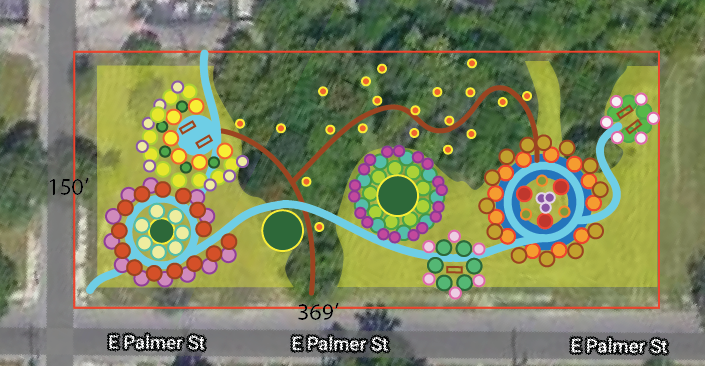Circle Forest is happening! We are so encouraged by the big hearts and strong hands of the dozens of volunteers who have been getting this project going in these early days. We’ve had folx from Lansing, Ann Arbor, East Side, West Side, and across the street. A community is forming around this project unlike any we have undertaken. We seem to be speaking the same inspiration and working together to make a special place that speaks to the past and the future. What else could we ask for?
It’s been hard work and everyone is energized by the huge accomplishments. We filled our first dumpster with garbage excavated from the forest. It really feels like the forest and we can really breathe in there now. We pulled iron bed frames, mattresses, kiddie pools, hoses, hundreds of feet of chain link and barbed wire, vintage styrofoam, carpeting, shingles, tires, and other strange relics of man.
We’ve created about 50 yards of inviting pathways into and through the woods. We cleared English Ivy from trees and paths and replaced it all with fresh wood chips of all varieties and fragrance. Working in the circle forest is a refreshing olfactory reset. Imagine three hours of just first oxygen and cedar wood chip wafts.
As we gain access to new sections of the forest we are clearing more garbage and doing an assessment of the canopy and inventorying tree species. We are faced with tough decisions and reckoning about labels such as “invasive” and “native” and what these mean for our project. We have to weigh out a tree's desire to be in this forest, the benefits it has offered long before we got here, and its ability to share and even support native trees. We hesitate to cut most trees in the forest sections of the project, understanding the assistance they will offer the new trees both in stress reduction from shade and existing mycorrhizae community. This means that we want to honor both the trees and fungi that exist here and have made the forest what it is.
Of course even the “dead” trees are full of life and have a key role here. Even using the word “dead” gives me pause because often trees that are no longer photosynthesizing harbor more life than when they were. We will remove trees that are weak and in danger of falling and leave the snags. These are “dead” wood trees that harbor lots of insects, birds, and even new trees. We believe it is important to keep all the woody debris we find and create on the site. All of this biomass provides moisture retention, habitat, and fertilizer for life. Part of what makes a forest a forest is its ability and desire to subsume itself, to recycle all and bring it back to life.
——— What’s next? ———
Over the coming weeks we will be terraforming. We will take this flat land and help it dance. We will bring undulations to the landscape by forming small hills with valley rings around them. This will allow us to import better soil into the rings into which we will plant the tree groves. Each ring will welcome a different species that will join forces and grow as a family. The mound in the center of each ring will shed water to the trees, giving them a better shot at long term survival amidst these climate challenges.
The last two volunteer workdays for the season are 3pm to 6pm on Sundays October 17th and 31st, with fire and soup at 6pm. If you have a group you would like to bring ( 4 people or more ), please email us and we can arrange a different time that suits your group’s schedule.
And lastly, we are celebrating the closing of this first phase of the project on Halloween, with - guess what - a fire at 6pm after the workday, with food and music. You’re welcome to join us!
——————————
You can donate to this project here, or Venmo @arbdetroit
——————————
3100 Palmer st. Detroit, MI 48211 --- www.arbdetroit.org/circle-forest —- treetroit@gmail.com












